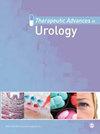经皮肾造瘘术与逆行输尿管支架植入术治疗急性梗阻性上尿路感染的围手术期疗效和安全性的 Meta 分析
IF 3.5
4区 医学
Q2 UROLOGY & NEPHROLOGY
引用次数: 0
摘要
背景:关于急性梗阻性上尿路感染的最佳引流方法的争论一直存在,主要集中在经皮肾造瘘术(PCN)和逆行输尿管支架置入术(RUS)之间的选择上。方法:根据《系统综述和元分析首选报告项目》(Preferred Reporting Items for Systematic Review and Meta-analysis,PRISMA)声明的指导原则,利用 Medline、Embase、Web of Science 和 Cochrane 数据库(截至 2022 年 12 月)进行了全面调查。使用的关键词包括 "PCN"、"RUS"、"急性上梗阻性尿路病变 "和 "RCT"。纳入标准包括提供准确和可分析数据的研究,其中包括受试者总数、围手术期结果和并发症发生率。评估的围手术期结果包括透视时间、体温正常化、血清肌酐正常化、白细胞(WBC)计数正常化和手术时间。安全性结果包括失败率、术中和术后血尿、术后发热、术后疼痛以及术后肾造瘘管或支架滑脱率。研究方案在PROSPERO(CRD42022352474)上进行了前瞻性注册。结果:荟萃分析包括7项试验,涉及727名患者,其中412人被分配到PCN组,315人被分配到RUS组。荟萃分析结果显示,PCN 组术后血尿发生率降低[几率比(OR)= 0.54,95% 置信区间(CI)0.30-0.99,P = 0.04],插入失败频率降低(OR = 0.42,95% CI 0.21-0.81,P = 0.01)。此外,RUS 组的透视时间比 PCN 组更短(平均差异 = 0.31,95% CI 0.14-0.48,p = 0.0004)。本文章由计算机程序翻译,如有差异,请以英文原文为准。
Meta-analysis of perioperative outcomes and safety of percutaneous nephrostomy versus retrograde ureteral stenting in the treatment of acute obstructive upper urinary tract infection
Background:The debate regarding the optimal drainage method for acute obstructive upper urinary tract infection persists, focusing on the choice between percutaneous nephrostomy (PCN) and retrograde ureteral stenting (RUS).Aims:This study aims to systematically examine the perioperative outcomes and safety associated with PCN and RUS in treating acute obstructive upper urinary tract infections.Methods:A comprehensive investigation was conducted using the Medline, Embase, Web of Science, and Cochrane databases up to December 2022, following the guidelines of the Preferred Reporting Items for Systematic Review and Meta-analysis (PRISMA) statement. The utilized keywords included ‘PCN’, ‘RUS’, ‘acute upper obstructive uropathy’, and ‘RCT’. Inclusion criteria encompassed studies providing accurate and analyzable data, which incorporated the total subject count, perioperative outcomes, and complication rates. The assessed perioperative outcomes included fluoroscopy time, normalization of temperature, normalization of serum creatinine, normalization of white blood cell (WBC) count, and operative time. Safety outcomes encompassed failure rate, intraoperative and postoperative hematuria, postoperative fever, postoperative pain, and postoperative nephrostomy tube or stent slippage rate. The study protocol was prospectively registered at PROSPERO (CRD42022352474).Results:The meta-analysis encompassed 7 trials involving 727 patients, with 412 assigned to the PCN group and 315 to the RUS group. The outcome of the meta-analysis unveiled a reduced occurrence of postoperative hematuria in the PCN group [odds ratio (OR) = 0.54, 95% confidence interval (CI) 0.30–0.99, p = 0.04], along with a decreased frequency of insertion failure (OR = 0.42, 95% CI 0.21–0.81, p = 0.01). In addition, the RUS group exhibited a shorter fluoroscopy time than the PCN group (mean difference = 0.31, 95% CI 0.14–0.48, p = 0.0004).Conclusion:Given the significant impact of hematuria and catheterization failure on postoperative quality of life, the preference for PCN appears more advantageous than RUS.
求助全文
通过发布文献求助,成功后即可免费获取论文全文。
去求助
来源期刊

Therapeutic Advances in Urology
Medicine-Urology
CiteScore
3.70
自引率
0.00%
发文量
39
审稿时长
10 weeks
期刊介绍:
Therapeutic Advances in Urology delivers the highest quality peer-reviewed articles, reviews, and scholarly comment on pioneering efforts and innovative studies across all areas of urology.
The journal has a strong clinical and pharmacological focus and is aimed at clinicians and researchers in urology, providing a forum in print and online for publishing the highest quality articles in this area. The editors welcome articles of current interest across all areas of urology, including treatment of urological disorders, with a focus on emerging pharmacological therapies.
 求助内容:
求助内容: 应助结果提醒方式:
应助结果提醒方式:


